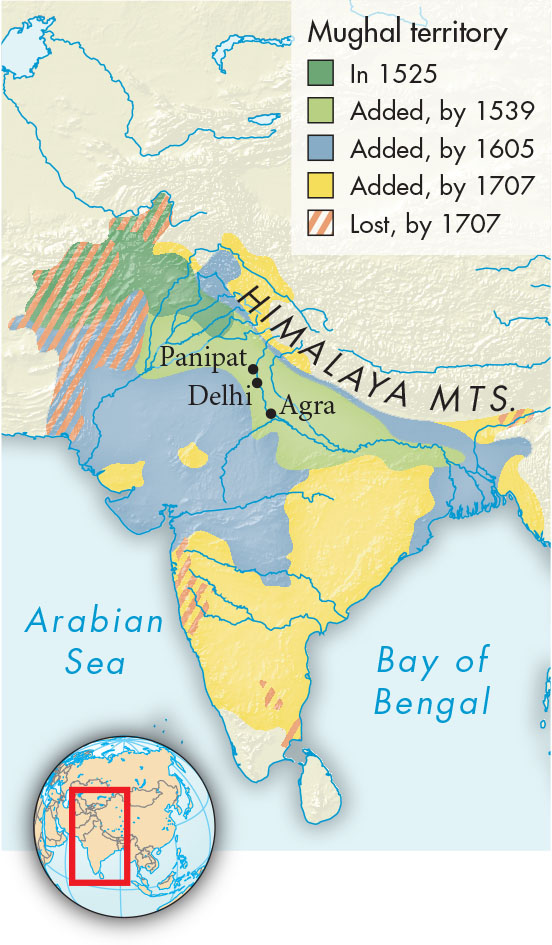A History of World Societies:
Printed Page 496
A History of World Societies Value
Edition: Printed Page 497
Chapter Chronology
The Mughal Empire in India
Of the three great Islamic empires of the early modern world, the Mughal Empire of India was the largest, wealthiest, and most populous. Extending over 1.2 million square miles at the end of the seventeenth century, with a population between 100 and 150 million, and with fabulous wealth and resources, the Mughal Empire surpassed the other two by a wide margin. In the sixteenth century only the Ming Dynasty in China could compare.
In 1504 Babur (r. 1483–1530), a Turkish ruler forced out of a small territory in Central Asia, captured Kabul and established a kingdom in Afghanistan. An adventurer who claimed descent from Chinggis Khan and Timur, Babur moved southward in search of resources to restore his fortunes. In 1526, with a force that was small (twelve thousand in number) but was equipped with firearms, Babur defeated the sultan of Delhi at Panipat. Babur’s capture of the cities of Agra and Delhi, key fortresses of the north, paved the way for further conquests in northern India. Although many of his soldiers wished to return north with their spoils, Babur decided to stay in India. A gifted writer, Babur wrote an autobiography in Turkish that recounts his military campaigns, describes places and people he encountered, recounts his difficulties giving up wine, and shows his wide-ranging interests in everything from fruit and swimming to a Turkish general who excelled at leapfrog. He was not particularly impressed by India, as can be inferred from this description in his memoirs:
Hindustan is a country which has few pleasures to recommend it. The people are not handsome. They have no idea of the charms of friendly society, of frankly mixing together, or familiar discourse. They have no genius, no comprehension of mind, no politeness of manner, no kindness or fellow-feeling, no ingenuity or mechanical invention in planning or executing their handicraft works, no skill or knowledge in design or architecture; they have no horses, no good flesh, no grapes or muskmelons, no good fruits, no ice or cold water, no good food or bread in their bazaars, no baths or colleges, no candles, no torches, not a candlestick.1
During the reign of Babur’s son Humayun (r. 1530–1540 and 1555–1556), the Mughals lost most of their territories in Afghanistan. Humayun went into temporary exile in Persia, where he developed a deep appreciation for Persian art and literature. The reign of Humayun’s son Akbar (r. 1556–1605) may well have been the greatest in the history of India. A boy of thirteen when he succeeded to the throne, Akbar pursued expansionist policies. Under his dynamic leadership, the Mughal state took definitive form and encompassed most of the subcontinent north of the Godavari River. No kingdom or coalition of kingdoms could long resist Akbar’s armies. The once-independent states of northern India were forced into a centralized political system under the sole authority of the Mughal emperor.

The Mughal Empire, 1526–1857
Akbar replaced Turkish with Persian as the official language of the Mughal Empire, and Persian remained the official language until the British replaced it with English in 1835. To govern this vast region, Akbar developed an administrative bureaucracy centered on four co-equal ministers: finance and revenue; the army and intelligence; the judiciary and religious patronage; and the imperial household, whose jurisdiction included roads, bridges, and infrastructure throughout the empire. Under Akbar’s Hindu finance minister, Raja Todar Mal, a uniform system of taxes was put in place. In the provinces imperial governors were appointed by and responsible solely to the emperor. Whereas the Ottoman sultans and Safavid shahs made extensive use of slaves acquired from non-Muslim lands for military and administrative positions, Akbar used the services of royal princes, nobles, and warrior-aristocrats. Initially these men were Muslims from Central Asia, but to reduce their influence, Akbar vigorously recruited Persians and Hindus. No single ethnic or religious faction could challenge the emperor.
Akbar’s descendants extended the Mughal Empire further. His son Jahangir (r. 1605–1628) lacked his father’s military abilities and administrative genius, but he did succeed in consolidating Mughal rule in Bengal. (See “Viewpoints 17.1: Jahangir and Louis XIV on Priorities for Monarchs.”) Jahangir’s son Shah Jahan (r. 1628–1658) launched fresh territorial expansion. Faced with dangerous revolts by the Muslims in Ahmadnagar and the resistance of the newly arrived Portuguese in Bengal, Shah Jahan not only crushed this opposition but also strengthened his northwestern frontier. Shah Jahan’s son Aurangzeb (r. 1658–1707), unwilling to wait for his father to die, deposed him and confined him for years in a small cell. A puritanically devout and strictly orthodox Muslim, as well as a skillful general and a clever diplomat, Aurangzeb ruled more of India than did any previous Mughal emperor, having extended the realm deeper into south India. His reign, however, also marked the beginning of the empire’s decline. His non-Muslim subjects were not pleased with his religious zealotry, and his military campaigns were costly. In the south resistance to Mughal rule led to major uprisings. (For more on Aurangzeb’s rule, see “Non-Muslims Under Muslim Rule.”)
